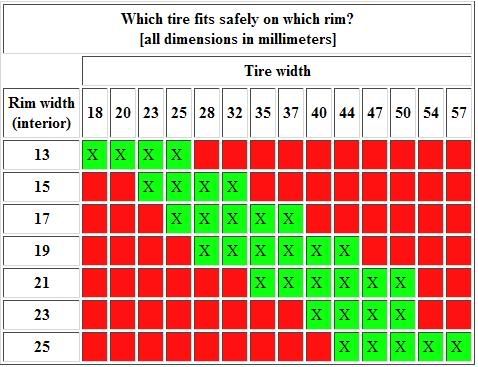-
• #2
I feel like I should know the maths of this.
-
• #3
7/8ths of the way down the page
-
• #4
-
• #5
jeez dave, that's neg reps you toe-rag.
-
• #6
The bottom of this page may help though.
http://www.sheldonbrown.com/tire_sizing.htmlTOO LATE
-
• #7
dammit, i did try a search of the tinters but found nothing - thanks guys
-
• #8
Also, try this which states:
Tyre–rim compatibility
Two tyres with the same ISO markings are completely interchangeable, even if one seems to be metric and the other is also marked in inches: e.g. 650B and 26×1½ are both 38-584 and should be marked accordingly. Look for the ISO numbers and you always know exactly where you are. Some rims are also now marked according to ISO with their bead diameter and internal section (width where the tyre fits): e.g. 622–17 for the size usually fitted to touring and hybrid bikes. But some manufacturers give the overall width instead. Subtract 6mm from overall width to estimate the rim section, or simply measure the distance between the flanges. If the rim is not marked with its bead diameter you can read this from the tyre – it’s the one dimension they have in common.
The ideal relationship between tyre and rim section is about 1.8 to 1, but any tyre from 1.4 to 2.2 times should fit – always provided that the bead diameters correspond.
Nowadays nearly all rims have hooked flanges (required to retain folding tyres) that will hang onto tyres up to three times their width. This increases the cushioning effect: you get more comfort out of the same tyre at the same pressure when you fit it to a narrow rim – yet it still rolls just as easily. On the other hand it increases the stress on the sidewall of the tyre. Mountain-bike tyres are designed to take this extra stress but road tyres are not. Another reason not to exceed the 2.2 limit on road is that a more bulbous tyre can deflect sideways with a noticeable effect on control and roadholding. Conversely, fitting a tyre of less than 1.4 times the rim section will result in a harsh ride and more rolling drag than a larger tyre at the same pressure. -
• #9

 Object
Object tomasito
tomasito TheBrick(Tommy)
TheBrick(Tommy) mattmadegood
mattmadegood Dylan
Dylan
anybody have any fancy equations for working out the maximum and minimum tire widths for a given rim inner width?
I've read somewhere that minimum tire size should be 1.4 times the inner rim width, so if i had a rim that had an 18mm inner width, the minimum tire width should be around 25mm - does this sound about right to you?